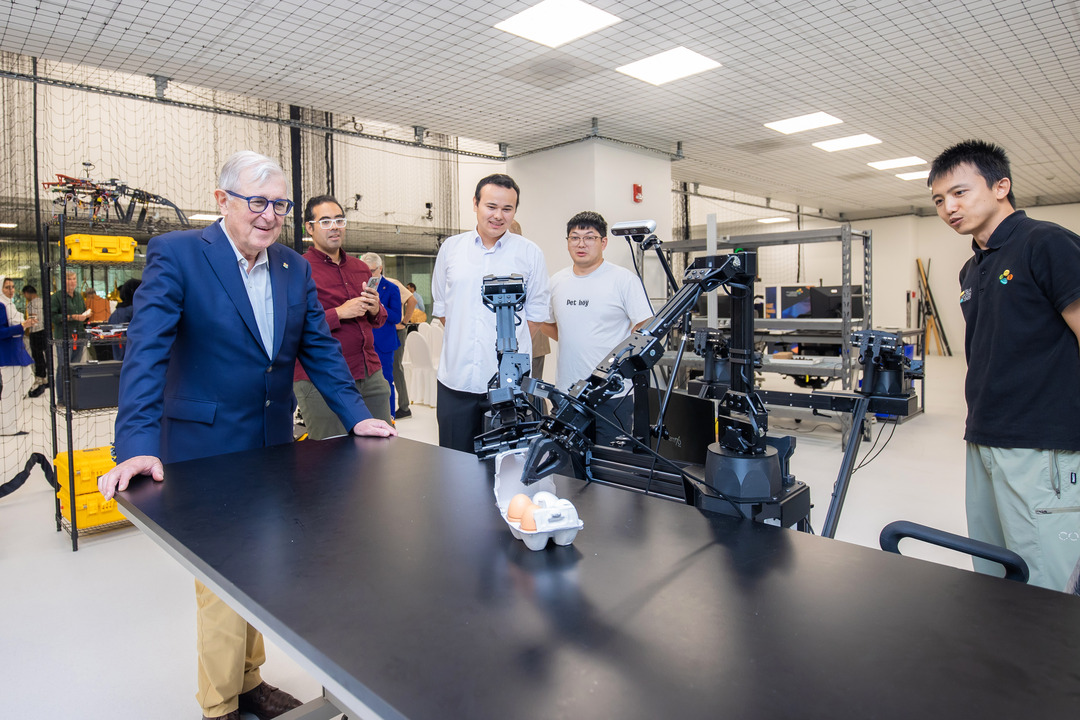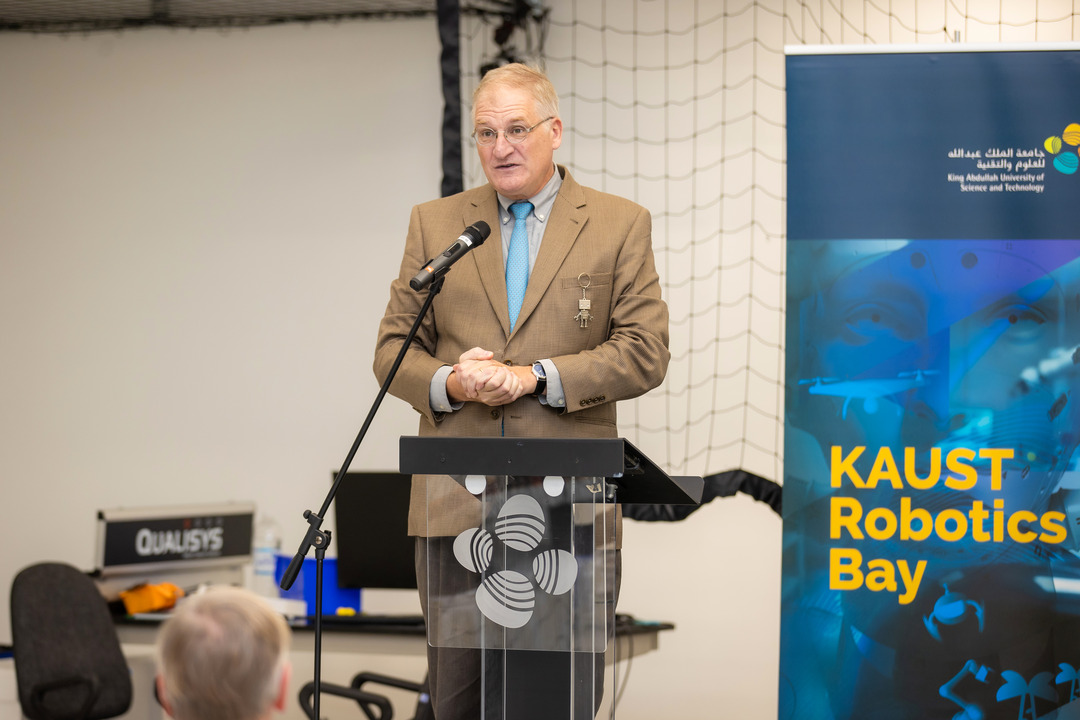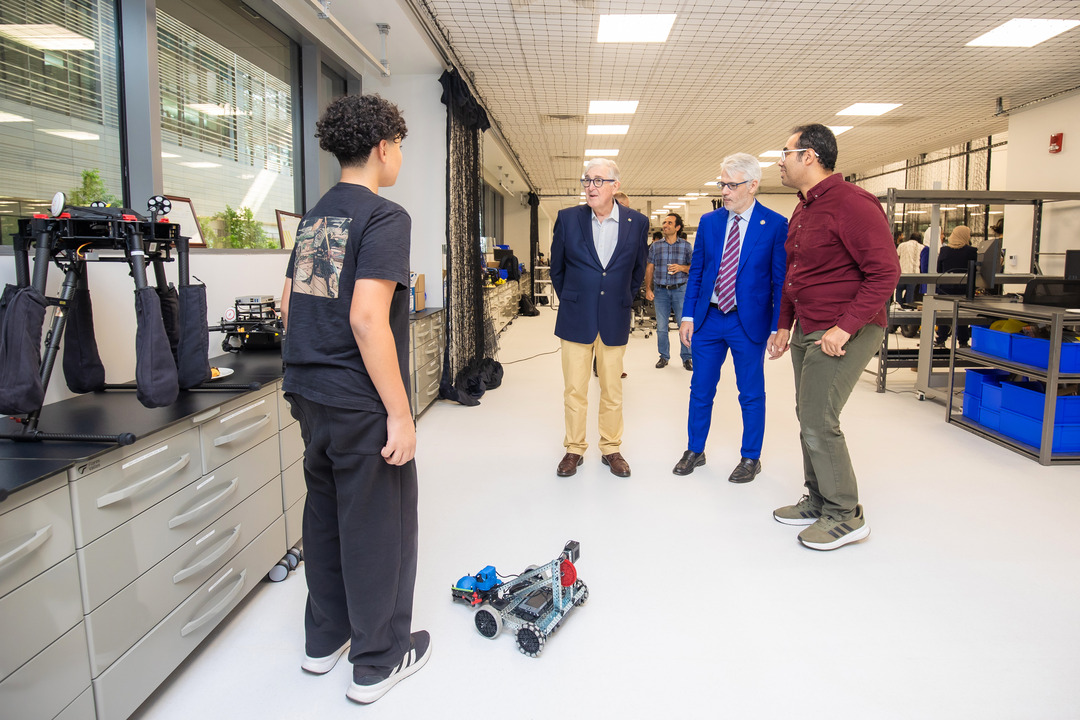KAUST’s new Robotics Bay advances the Kingdom’s robotics and AI capabilities

KAUST President Sir Edward Byrne AC, left, observes robotics in action during the launch of the new Robotics Bay facility
King Abdullah University of Science and Technology (KAUST) has launched the Robotics Bay — a purpose-built facility for designing, testing, and prototyping advanced robotic and autonomous systems.
Located on campus, the 1,000-square-meter interdisciplinary research facility was inaugurated on October 13. It strengthens the Kingdom’s capabilities in robotics and artificial intelligence while advancing Saudi Vision 2030 objectives for economic diversification and knowledge-based development.
“Robotics and automation are integral to Saudi Arabia’s digital transformation agenda,” said Professor Gianluca Setti, dean of the KAUST Computer, Electrical and Mathematical Sciences and Engineering (CEMSE) Division. “With the launch of the Robotics Bay, KAUST reaffirms its commitment to driving technological innovation and delivering solutions that strengthen the Kingdom's economy and society.”
Under the supervision of Electrical and Computer Engineering faculty members Professor Eric Feron and Assistant Professor Shinkyu Park, KAUST’s new facility fosters a culture of discovery and entrepreneurship in robotics, positioning the University as a key engine of high-tech transformation in Saudi Arabia.

Professor Eric Feron, Electrical and Computer Engineering, speaks during the launch of the Robotics Bay at KAUST.
“The key element brought by the Robotics Bay is the presence of an exceptional common development space where several researchers can work on their experiments in parallel while enjoying the creativity that can only be triggered by the presence of their neighbors,” Feron said.
Available to KAUST faculty, students, and collaborators across disciplines, the Robotics Bay also welcomes national partners seeking to develop and test robotic systems. Its centerpiece is a high-bay arena for aerial and ground robot trials, surrounded by specialized labs that support faculty-led exploration and development.
Designed to accommodate a wide range of robotic systems simultaneously, KAUST’s new facility supports research on aerial, ground, and underwater platforms in a single integrated environment.
Centrally located on campus for ease of access by researchers, the Robotics Bay is equipped with 400-volt electrical outlets to accommodate energy-intensive robotic systems and experiments. A motion-capture system and dedicated flight zones enable experiments with drones and multi-agent systems, while infrastructure for robotic manipulators, autonomous fleets, and underwater vehicles expands its scope.
Prototyping tools, including 3D printers, computer numerical control machines, and soldering stations, provide the resources needed to develop next-generation intelligent machines in collaboration with national partners, KAUST faculty and students, and industry. With these tools, the Robotics Bay bridges research and application, accelerating Saudi Arabia’s robotics future.
Enabling national priorities
The Robotics Bay directly contributes to technologies that underpin smart cities, autonomous mobility, advanced infrastructure, and public services. These advances are central to the Kingdom’s giga-projects.
“As a researcher heavily involved in aeronautics and transportation, the Robotics Bay offers a large central section that is extremely well suited for scaled-down, multimodal mobility experiments,” Feron said. He noted opportunities to connect with the world’s first multimodal testing ground for mobility technologies across land, air and sea — also located on campus.
“For example, the Robotics Bay could be the ideal place to deploy a scaled-down replica of KAUST’s Future Mobility Sandbox, allowing researchers to test their ideas before outdoor deployment.”

The new Robotics Bay can accommodate research on a variety of robot types for a multitude of purposes.
A training ground for the next generation of robotics and AI specialists, the facility strengthens national human capital in high-tech sectors, building the Kingdom’s long-term expertise and reducing reliance on imported knowledge. The Robotics Bay also advances locally developed robotics applications, benefiting logistics, agriculture, inspection, and defense at both local and national levels.
By providing a world-class robotics facility, KAUST enhances the Kingdom’s global standing in science, technology, and engineering research.
Globally competitive facility
Research at the Robotics Bay is diverse, ranging from agile ground and aerial robots to human-robot collaboration, multi-robot swarms, and robotics for marine operations. The facility is comparable to leading robotics centers at the University of California San Diego, the California Institute of Technology, and the University of Michigan.
Serving as a central facility for robotics research and experimentation, it provides world-class infrastructure that enables entrepreneurial growth and strengthens the link between academia and industry in Saudi Arabia. Feron said research equipment such as the indoor positioning system developed by Park is durable, designed for long-term use, and positions KAUST to make significant contributions in this highly technological domain.
“The sheer size of the facility and its indoor positioning system make the Robotics Bay a very attractive option for all research activities involving mobile robotics, including the ongoing revolution in personal mobility.”

